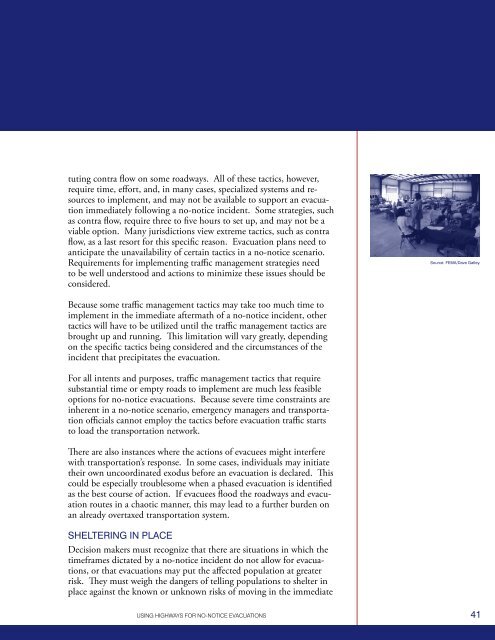using highways for no-notice evacuations - FHWA Operations - U.S. ...
using highways for no-notice evacuations - FHWA Operations - U.S. ...
using highways for no-notice evacuations - FHWA Operations - U.S. ...
Create successful ePaper yourself
Turn your PDF publications into a flip-book with our unique Google optimized e-Paper software.
tuting contra flow on some roadways. All of these tactics, however,require time, ef<strong>for</strong>t, and, in many cases, specialized systems and resourcesto implement, and may <strong>no</strong>t be available to support an evacuationimmediately following a <strong>no</strong>-<strong>no</strong>tice incident. Some strategies, suchas contra flow, require three to five hours to set up, and may <strong>no</strong>t be aviable option. Many jurisdictions view extreme tactics, such as contraflow, as a last resort <strong>for</strong> this specific reason. Evacuation plans need toanticipate the unavailability of certain tactics in a <strong>no</strong>-<strong>no</strong>tice scenario.Requirements <strong>for</strong> implementing traffic management strategies needto be well understood and actions to minimize these issues should beconsidered.Source: FEMA/Dave Gatley.Because some traffic management tactics may take too much time toimplement in the immediate aftermath of a <strong>no</strong>-<strong>no</strong>tice incident, othertactics will have to be utilized until the traffic management tactics arebrought up and running. This limitation will vary greatly, dependingon the specific tactics being considered and the circumstances of theincident that precipitates the evacuation.For all intents and purposes, traffic management tactics that requiresubstantial time or empty roads to implement are much less feasibleoptions <strong>for</strong> <strong>no</strong>-<strong>no</strong>tice <strong>evacuations</strong>. Because severe time constraints areinherent in a <strong>no</strong>-<strong>no</strong>tice scenario, emergency managers and transportatio<strong>no</strong>fficials can<strong>no</strong>t employ the tactics be<strong>for</strong>e evacuation traffic startsto load the transportation network.There are also instances where the actions of evacuees might interferewith transportation’s response. In some cases, individuals may initiatetheir own uncoordinated exodus be<strong>for</strong>e an evacuation is declared. Thiscould be especially troublesome when a phased evacuation is identifiedas the best course of action. If evacuees flood the roadways and evacuationroutes in a chaotic manner, this may lead to a further burden onan already overtaxed transportation system.SHELTERING IN PLACEDecision makers must recognize that there are situations in which thetimeframes dictated by a <strong>no</strong>-<strong>no</strong>tice incident do <strong>no</strong>t allow <strong>for</strong> <strong>evacuations</strong>,or that <strong>evacuations</strong> may put the affected population at greaterrisk. They must weigh the dangers of telling populations to shelter inplace against the k<strong>no</strong>wn or unk<strong>no</strong>wn risks of moving in the immediateUSING HIGHWAYS FOR NO-NOTICE EVACUATIONS41
















